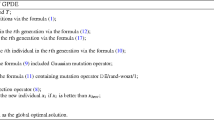Abstract
During the recent decades, much effort has been dedicated to revise and improve the evolution operators of evolutionary algorithms. This article aims at minimums of an efficient mutation operator in continuous problems for which reachability, scalability, unbiasedness and isotropy have already been considered necessary. A new requirement, called robust exploration and exploitation trade-off, is introduced which is usually satisfied for common univariate density functions in 1D space, while for higher dimensions, these density functions should be revised, otherwise the exploration or exploitation abilities of sampling turns highly limited. Empirical simulation is carried out to check the validity of the drawn conclusions, which verifies that if modification of the density function is ignored, dramatic performance deterioration can be concluded.
Similar content being viewed by others
References
Akay, A., Karaboga, D.: A modified Artificial Bee Colony algorithm for real-parameter optimization. Inform. Sci. (2010, in press)
Auger, A., Hansen, N.: A restart CMA evolution strategy with increasing population size. In: Proceedings of Congress on Evolutionary Computation, 1769–1776 (2005)
Back T., Hammel U., Schwefel H-P.: Evolutionary computation: comments on the history and current state. IEEE. Trans. Evol. Comput. 1(1), 3–17 (1997)
Beyer H.-G., Schwefel H-P.: Evolution strategies—a comprehensive introduction. Nat. Comput. 1, 3–52 (2002)
COmparing Continuous Optimisers. http://coco.gforge.inria.fr/doku.php?id=bbob-2009-results
Garcia S., Molina D., Lozano M., Herrera F.: A study on the use of non-parametric tests for analyzing the evolutionary algorithms’ behaviour: a case study on the CEC’2005 special session on real parameter optimization. J. Heuristics 15, 617–644 (2009)
Hansen, N., Gemperle, F., Auger, A., Koumoutsakos, P.: When do heavy-tail distributions help? In: Proceedings of PPSN’2006, pp. 62–71 (2006)
Meyer-Nieberg1, S., Beyer, H-G.: Self-adaptation in evolutionary algorithms. In: Parameter Setting in Evolutionary Algorithms, pp. 47–75. Springer, Berlin (2007)
Ohkura K.: Robust evolution strategy. Appl. Intell. 15, 153–169 (2001)
Schwefel, H-P., Rudolph, G., Back, T.: Contemporary evolution strategies. In: Technical Report of the Systems Analysis Research Group SYS-6/95. Department of Computer Science, University of Dortmund, Dortmund (1995).
Schwefel H-P., Schwefel H-P.: Evolution and Optimum Seeking. Wiley, New York (1995)
Seredynski F.: Evolutionary paradigms. In: Zomaya, A.Y. (ed.) Handbook of Nature—Inspired and Innovative Computing: Integrating Classical Models with Emerging Technologies., pp. 111–146. Springer, New Jersey (2006)
Author information
Authors and Affiliations
Corresponding author
Rights and permissions
About this article
Cite this article
Ahrari, A. A requirement for the mutation operator in continuous optimization. Optim Lett 7, 1681–1690 (2013). https://doi.org/10.1007/s11590-012-0514-4
Received:
Accepted:
Published:
Issue Date:
DOI: https://doi.org/10.1007/s11590-012-0514-4




